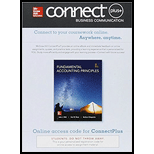
Connect 2-Semester Access Card for Fundamental Accounting Principles
22nd Edition
ISBN: 9780077632755
Author: John Wild
Publisher: McGraw-Hill Education
expand_more
expand_more
format_list_bulleted
Concept explainers
Question
Chapter 19, Problem 2E
To determine
Concept Introduction:
Fixed and Variable Costs in Manufacturing
- Variable costs refer to the costs of manufacture that have a direct co-relation with the volume of the goods manufactured, i.e. the costs increase with an increase in the goods produced. Examples are costs of direct material and direct labor.
Manufacturing costs are costs that are directly incurred in connection with manufacture of goods. Examples are Direct materials and Manufacturing Overhead
Cost allocation of
- Cost allocation of Overheads takes place on basis of cost objects identified to enable cost allocation. Overheads refer to costs of operations and comprise of direct costs such as manufacturing expenses indirect costs in the form of selling and administrative expenses.
- Examples of Overheads are Salaries of administrative staff, rent of office, advertising expenses etc. The costs of the operations are allocated on basis of cost objects. Cost objects are units of cost allocation identified for overhead allocations and cost estimations.
- Examples of Cost objects for Overhead allocation are Number of units produced, number of labor hours worked etc.
To Determine:
Total cost of the job
Solution:
The total cost of the job is $5,085.
Expert Solution & Answer
Want to see the full answer?
Check out a sample textbook solution
Students have asked these similar questions
Subject : General accounting question
I want to this question answer for General accounting question not need ai solution
Please explain the solution to this general accounting problem with accurate principles.
Chapter 19 Solutions
Connect 2-Semester Access Card for Fundamental Accounting Principles
Ch. 19 - Prob. 1DQCh. 19 - Prob. 2DQCh. 19 - Prob. 3DQCh. 19 - Prob. 4DQCh. 19 - Prob. 5DQCh. 19 - Prob. 6DQCh. 19 - Prob. 7DQCh. 19 - Prob. 8DQCh. 19 - Prob. 9DQCh. 19 - Prob. 10DQ
Ch. 19 - Prob. 11DQCh. 19 - Prob. 12DQCh. 19 - Prob. 13DQCh. 19 - Prob. 14DQCh. 19 - Prob. 1QSCh. 19 - Prob. 2QSCh. 19 - Prob. 3QSCh. 19 - Prob. 4QSCh. 19 - Prob. 5QSCh. 19 - Prob. 6QSCh. 19 - Prob. 7QSCh. 19 - Prob. 8QSCh. 19 - Prob. 9QSCh. 19 - Prob. 10QSCh. 19 - Prob. 11QSCh. 19 - Manufacturing cost flows P1 P2 P3 Refer to the...Ch. 19 - Prob. 13QSCh. 19 - Prob. 14QSCh. 19 - Prob. 1ECh. 19 - Prob. 2ECh. 19 - Prob. 3ECh. 19 - Prob. 4ECh. 19 - Prob. 5ECh. 19 - Prob. 6ECh. 19 - Prob. 7ECh. 19 - Prob. 8ECh. 19 - Prob. 9ECh. 19 - Prob. 10ECh. 19 - Prob. 11ECh. 19 - Prob. 12ECh. 19 - Prob. 13ECh. 19 - Prob. 14ECh. 19 - Prob. 15ECh. 19 - Prob. 16ECh. 19 - Prob. 17ECh. 19 - Exercise 19-18 Job order costing for services A1...Ch. 19 - A recent balance sheet for Porsche AG shows...Ch. 19 - Problem 19-1A
Production costs computed and...Ch. 19 - Prob. 2APSACh. 19 - Prob. 3APSACh. 19 - Prob. 4APSACh. 19 - Prob. 5APSACh. 19 - Prob. 1BPSBCh. 19 - Prob. 2BPSBCh. 19 - Problem 19-3B
Source documents, journal entries,...Ch. 19 - Prob. 4BPSBCh. 19 - Prob. 5BPSBCh. 19 - The computer workstation furniture manufacturing...Ch. 19 - Prob. 1GLPCh. 19 - Prob. 1BTNCh. 19 - Prob. 2BTNCh. 19 - Prob. 3BTNCh. 19 - Prob. 4BTNCh. 19 - Prob. 5BTNCh. 19 - Prob. 6BTNCh. 19 - Prob. 7BTNCh. 19 - Prob. 8BTNCh. 19 - Apple and Samsung are competitors in the global...
Knowledge Booster
Learn more about
Need a deep-dive on the concept behind this application? Look no further. Learn more about this topic, accounting and related others by exploring similar questions and additional content below.Similar questions
- 82. What role does assurance boundary definition play in attestation? a) Standard limits work always b) Boundaries never matter c) All areas need equal coverage d) Engagement scope limits determine verification responsibilitiesarrow_forwardCould you help me solve this financial accounting question using appropriate calculation techniques?arrow_forwardGiven solution for General accounting question not use aiarrow_forward
arrow_back_ios
SEE MORE QUESTIONS
arrow_forward_ios
Recommended textbooks for you

 AccountingAccountingISBN:9781337272094Author:WARREN, Carl S., Reeve, James M., Duchac, Jonathan E.Publisher:Cengage Learning,
AccountingAccountingISBN:9781337272094Author:WARREN, Carl S., Reeve, James M., Duchac, Jonathan E.Publisher:Cengage Learning, Accounting Information SystemsAccountingISBN:9781337619202Author:Hall, James A.Publisher:Cengage Learning,
Accounting Information SystemsAccountingISBN:9781337619202Author:Hall, James A.Publisher:Cengage Learning, Horngren's Cost Accounting: A Managerial Emphasis...AccountingISBN:9780134475585Author:Srikant M. Datar, Madhav V. RajanPublisher:PEARSON
Horngren's Cost Accounting: A Managerial Emphasis...AccountingISBN:9780134475585Author:Srikant M. Datar, Madhav V. RajanPublisher:PEARSON Intermediate AccountingAccountingISBN:9781259722660Author:J. David Spiceland, Mark W. Nelson, Wayne M ThomasPublisher:McGraw-Hill Education
Intermediate AccountingAccountingISBN:9781259722660Author:J. David Spiceland, Mark W. Nelson, Wayne M ThomasPublisher:McGraw-Hill Education Financial and Managerial AccountingAccountingISBN:9781259726705Author:John J Wild, Ken W. Shaw, Barbara Chiappetta Fundamental Accounting PrinciplesPublisher:McGraw-Hill Education
Financial and Managerial AccountingAccountingISBN:9781259726705Author:John J Wild, Ken W. Shaw, Barbara Chiappetta Fundamental Accounting PrinciplesPublisher:McGraw-Hill Education


Accounting
Accounting
ISBN:9781337272094
Author:WARREN, Carl S., Reeve, James M., Duchac, Jonathan E.
Publisher:Cengage Learning,

Accounting Information Systems
Accounting
ISBN:9781337619202
Author:Hall, James A.
Publisher:Cengage Learning,

Horngren's Cost Accounting: A Managerial Emphasis...
Accounting
ISBN:9780134475585
Author:Srikant M. Datar, Madhav V. Rajan
Publisher:PEARSON

Intermediate Accounting
Accounting
ISBN:9781259722660
Author:J. David Spiceland, Mark W. Nelson, Wayne M Thomas
Publisher:McGraw-Hill Education

Financial and Managerial Accounting
Accounting
ISBN:9781259726705
Author:John J Wild, Ken W. Shaw, Barbara Chiappetta Fundamental Accounting Principles
Publisher:McGraw-Hill Education
Cost Accounting - Definition, Purpose, Types, How it Works?; Author: WallStreetMojo;https://www.youtube.com/watch?v=AwrwUf8vYEY;License: Standard YouTube License, CC-BY